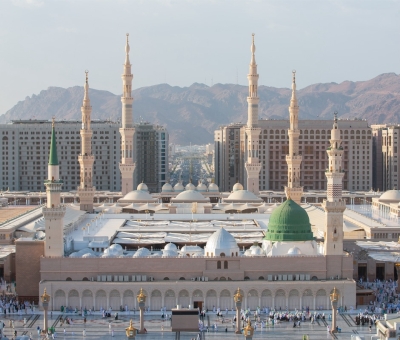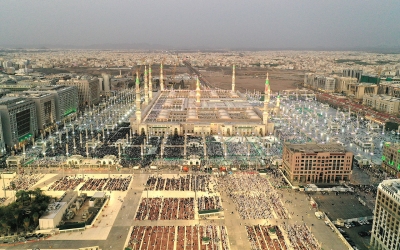
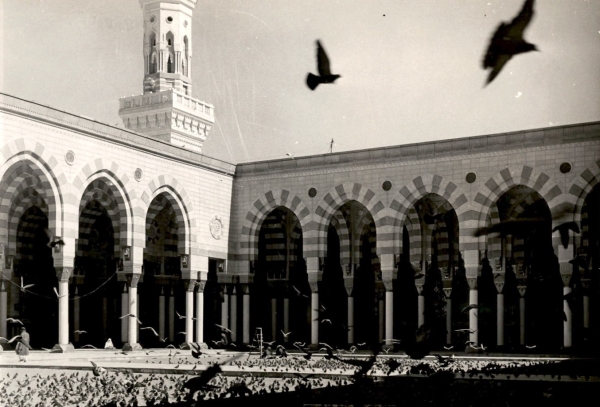
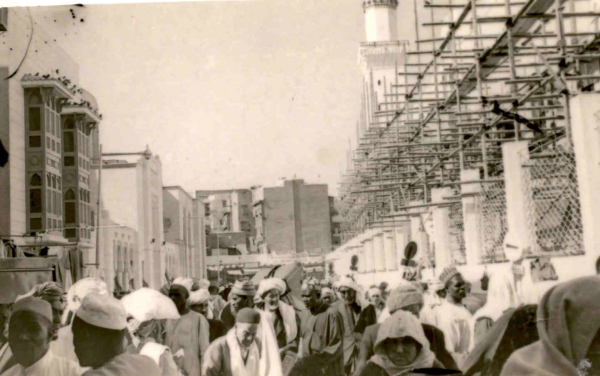
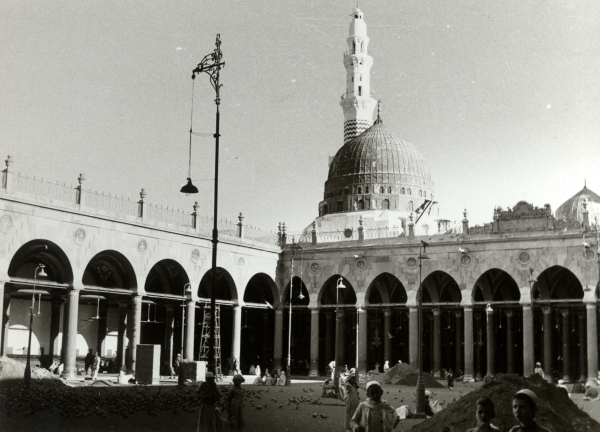
The First Saudi Expansion of the Prophet's Mosque is the first spatial and architectural ŌĆÄenlargement of the ProphetŌĆÖs Mosque in the Saudi era. It was first initiated by the ŌĆÄFounder King Abdulaziz Bin Abdulrahman Al Saud in 1949, and was ŌĆÄcompleted by his son King Saud Bin Abdulaziz Al Saud after the death of his father in 1955. It lasted for seven years. ŌĆÄ
Laying the foundation stone for the First Saudi Expansion of the Prophet's Mosque
Before the expansion, there had been several repairs and restorations, the first of ŌĆÄwhich was directed by King Abdulaziz Bin Abdulrahman Al Saud in 1931, to improve and repair floors, corridors, entrances, minarets, and to enclose the ŌĆÄcracked columns with iron belts that preserved them from further cracking and falling. ŌĆÄ
In 1946, a number of the stones relied upon for the integrity of the ŌĆÄbuilding disintegrated, and in 1949, King Abdulaziz Bin Abdulrahman Al ŌĆÄSaud announced, through a radio statement, the beginning of the first Saudi ŌĆÄexpansion of the ProphetŌĆÖs Mosque. ŌĆÄ
In 1952, the Crown Prince at that time, Prince Saud Bin Abdulaziz Al ŌĆÄSaud, laid the foundation stone for the Saudi expansion, on behalf of his father, King ŌĆÄAbdulaziz. During the following year, King Saud placed four stones in the northwest corner of the expansion, ŌĆÄcompleting the implementation of the expansion that his father had begun before he ŌĆÄdied. ŌĆÄ
The Main Expansion Work
The expansion extended from the Eastern WomenŌĆÖs Gate, Bab un Nisa, to Bab ŌĆÄUthman on the northern side of the ProphetŌĆÖs ŌĆÄMosque, and included the northern and western parts. The work stopped at Bab al-ŌĆÄRahmah. An area of 6,247 m┬▓ was added, starting from the building of the northern ŌĆÄside and reaching the mosque, an additional 6,024 m┬▓ was added, bringing the total of ŌĆÄthe first Saudi expansion to 12,271 m┬▓. ŌĆÄ
The expansion was executed using concrete structures, distributed among 706 round columns, including which 232 ŌĆÄcolumns are clad with brass heads engraved with arches covered with artificial stones, ŌĆÄin addition to forty-four windows and 170 flat domes. ŌĆÄ
The expansion consisted of fourteen porticos and two atria (an atrium is an unroofed floor). ŌĆÄAlso, five new doors were added to the five northern ones, bringing the total to ten ŌĆÄdoors. In addition, two minarets were constructed, each reaching a height of seventy-two m, ŌĆÄdivided into four floors, to double the minarets of the Prophet's Mosque to four, after ŌĆÄthey were only two. ŌĆÄ
In the First Saudi Expansion of the ProphetŌĆÖs Mosque, the first station for lighting the ŌĆÄProphetŌĆÖs Mosque was constructed, and the lamps were doubled to become 2,427 ŌĆÄlamps. The old and dilapidated buildings in the vicinity of the mosque were also ŌĆÄremoved after the completion of the expansion to harmonize the neighboring buildings ŌĆÄand facilities with the new form of the mosqueŌĆÖs architecture. For this purpose, a new ŌĆÄdoor called Bab Al-Siddique was added, and new rooms were built next to the door, ŌĆÄincreasing the area of the mosque to 16,327 m┬▓. ŌĆÄ
Continuing the work of the First Saudi Expansion of the Prophet's Mosque
Expansion works continued during the reign of King Faisal Bin Abdulaziz Al Saud, as ŌĆÄthe flow of visitors to the ProphetŌĆÖs Mosque increased, which necessitated an ŌĆÄenlargement in the area allocated for prayer. Therefore, in 1973, King ŌĆÄFaisal Bin Abdulaziz decided to convert the areas west of the mosque to prayer sites, ŌĆÄwith an area of 35,000 m┬▓ in the first phase, while in the second phase, it reached 5,550 ŌĆÄm┬▓, more than double the original area of the ProphetŌĆÖs Mosque before the expansion. ŌĆÄ
During the reign of King Faisal, the expansion was paved, and ŌĆÄfiberglass canopies were installed. Furthermore, it was provided by electricity services, ŌĆÄfans, loudspeakers, and mattresses. Its total area, including halls and outdoor yards, is ŌĆÄŌĆÄ40,550 m┬▓. ŌĆÄ
In 1977, King Khalid Bin Abdulaziz started the expansion of the ŌĆÄProphet's Mosque in the direction of the cloth market, the additional areas were added ŌĆÄto the expansion implemented by King Faisal. ŌĆÄ
The Second Saudi Expansion of the Prophet's Mosque
After the First Saudi Expansion ordered by King Abdulaziz, ŌĆÄimplemented by King Saud, then doubled by King Faisal, and further increased by King Khalid, the ŌĆÄSecond Saudi Expansion of the Prophet's Mosque was the expansion of King Fahd Bin ŌĆÄAbdulaziz Al Saud in 1984, and is called the "Second Saudi Expansion". ŌĆÄŌĆÄ
Related quizzes
